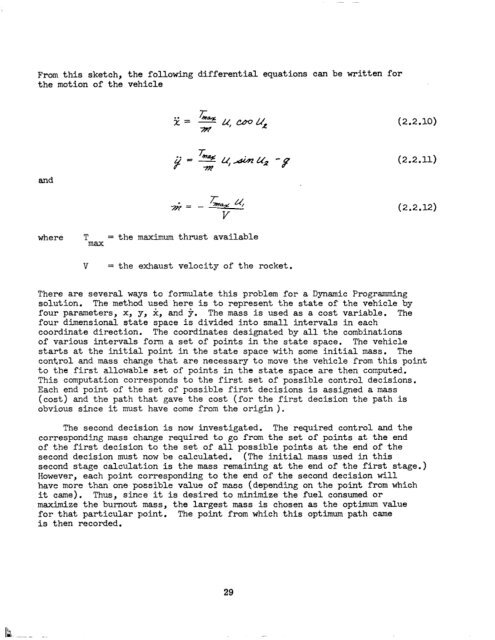guidance, flight mechanics and trajectory optimization
guidance, flight mechanics and trajectory optimization
guidance, flight mechanics and trajectory optimization
Create successful ePaper yourself
Turn your PDF publications into a flip-book with our unique Google optimized e-Paper software.
Ii--<br />
From this sketch, the following differential equations can be written for<br />
the motion of the vehicle<br />
<strong>and</strong><br />
*= - La+ u,<br />
V<br />
where T = the maximum thrust available<br />
max<br />
V = the exhaust velocity of the rocket.<br />
(2.2.10)<br />
(2.2.11)<br />
(2.2.12)<br />
There are several ways to formulate this problem for a Dynamic Programming<br />
solution. The method used here is to represent the state of the vehicle by<br />
four parameters, x, y, k, <strong>and</strong> y. The mass is used as a cost variable. The<br />
four dimensional state space is divided into small intervals in each<br />
coordinate direction. The coordinates designated by all the combinations<br />
of various intervals form a set of points in the state space. Tne vehicle<br />
starts at the initial point in the state space with some initial mass. The<br />
control <strong>and</strong> mass change that are necessary to move the vehicle from this point<br />
to the first allowable set of points in the state space are then computed.<br />
This computation corresponds to the first set of possible control decisions.<br />
Each end point of the set of possible first decisions is assigned a mass<br />
(cost) <strong>and</strong> the path that gave the cost (for the first decision the path is<br />
obvious since it must have come from the origin ).<br />
The second decision is now investigated. The required control <strong>and</strong> the<br />
correspondtig mass change required to go from the set of points at the end<br />
of the first decision to the set of all possible points at the end of the<br />
second decision must now be calculated. (The initial mass used jn this<br />
second stage calculation is the mass remaining at the end of the first stage.<br />
However, each point corresponding to the end of the second decision will<br />
have more than one possible value of mass (depending on the point from which<br />
it came). Thus, since it is desired to minimize the fuel consumed or<br />
maximize the burnout mass, the largest mass is chosen as the optimum value<br />
for that particular point. The point from which this optimum path came<br />
is then recorded.<br />
29<br />
>

















